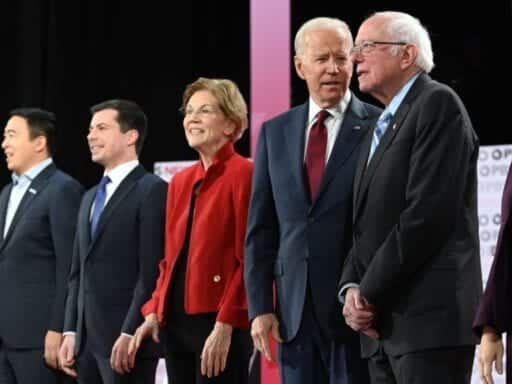Sen. Bernie Sanders has a strong base of support, but most Iowans still aren’t sure who they will caucus for.
Throughout the 2020 campaign for the Democratic presidential nomination, Sen. Bernie Sanders, Sen. Elizabeth Warren, former Vice President Joe Biden, and former Mayor Pete Buttigieg have topped most early primary state polls. Iowa and New Hampshire polls released late last week followed that trend, while also registering some important changes in position in the final weeks before voters caucus and cast ballots for the first time.
According to a Des Moines Register poll of likely Iowa caucusgoers released Friday, Sanders currently has the lead in that state, with 20 percent support — up 5 percentage points from the last poll released in November. Warren followed Sanders with 17 percent support; Buttigieg and Biden were third and fourth, with 16 and 15 percent respectively. The poll has a margin of error of 3.7 percentage points.
In New Hampshire, a Monmouth poll of likely primary voters shows the same four candidates clustered between 20 and 15 percent, with Buttigieg in the lead with 20 percent, Biden at 19 percent, Sanders at 18 percent, and Warren at 15 percent. That poll has a margin of error of 4.9 percentage points.
With such a tight race among multiple candidates, it’s difficult to reach conclusions on how the races in either state will shake out, particularly given the number of voters who remain undecided — and the number who say they could still change their minds. In Iowa, for instance, only 40 percent of caucusgoers say they have settled on a candidate for sure.
Still, with the Iowa caucuses only 23 days away, the results of the polls do suggest Sanders and Warren are well-positioned to finish strong in Iowa. Sanders, is of course first, and critically, Warren is a popular second choice — among combined first and second choice caucus plans, Warren leads in Iowa with 33 percent (16 percent said she was their second choice).
Second choices are important in Iowa because in each precinct, candidates must reach a threshold of 15 percent of caucusgoers to remain viable (in contention for delegates), which means that supporters of any candidate not reaching that threshold would be asked to support another candidate.
After Warren, Buttigieg — who topped November’s Iowa poll — has the highest second choice support, at 15 percent, also a promising showing. Biden and Sanders each had 12 percent of respondents chose them as their second choices.
And there is still a sizable number of likely caucusgoers who haven’t yet made up their minds: 45 percent said they could be persuaded to change their allegiance before the caucuses, and 15 percent either said they have no first choice, or aren’t at all sure who they’d like to caucus for. These caucusgoers will have a major impact on who wins the caucuses — and who has the momentum that win will grant in the New Hampshire primary.
What this means for the race
Iowans aren’t alone in their uncertainty. A recent CBS/YouGov poll showed that less than one third of likely New Hampshire Democratic primary voters have “definitely” made up their minds on a candidate.
That there are so many undecideds just three weeks from the Iowa caucuses and a month out from the New Hampshire primary shouldn’t come as a surprise, as Vox’s Ella Nilsen explained:
New Hampshire voters in particular are famous for deciding on a candidate at the last minute — sometimes right up until they go into the voting booth. And many of the dozens of voters I’ve spoken to at candidate events say that while they’re narrowing down to a few candidates, they still haven’t found The One yet.
That tracks in Iowa as well. The Hawkeye State holds caucuses on February 3 where voters literally have to sort themselves into groups based on the candidates they support. Voting happens out in the open, and candidate “viability” — or whether a candidate can reach a 15 percent threshold — matters hugely to their chances. This also increases the importance of people who support lower-tier candidates that won’t reach the viability threshold and have to throw their vote behind someone else.
Each state allocates its delegates to the Democratic National Convention in proportion to primary or caucus results. Each of the top four candidates have reason to be hopeful about their chances in at least one of the first two states in this election cycle, and that makes it seem unlikely that Democrats will have a clear nominee following the contests.
In recent years, the two states have produced different winners from each other. In 2016, Hillary Clinton took Iowa while Sanders stormed back a week later to take New Hampshire. In 2008, Barack Obama took Iowa, while Clinton followed up with a win in New Hampshire. (John Kerry did win both states in 2004, however.)
After Iowa and New Hampshire, all attention will turn to South Carolina and Nevada, where Joe Biden continues to maintain a healthy lead on his competitors — that lead could narrow, or even evaporate, based on what happens in the first two contests. From there, Democrats will sprint to Super Tuesday, the results of which ought to give a much clearer picture for how the race is likely to shake out at that point.
Author: Katelyn Burns
Read More



